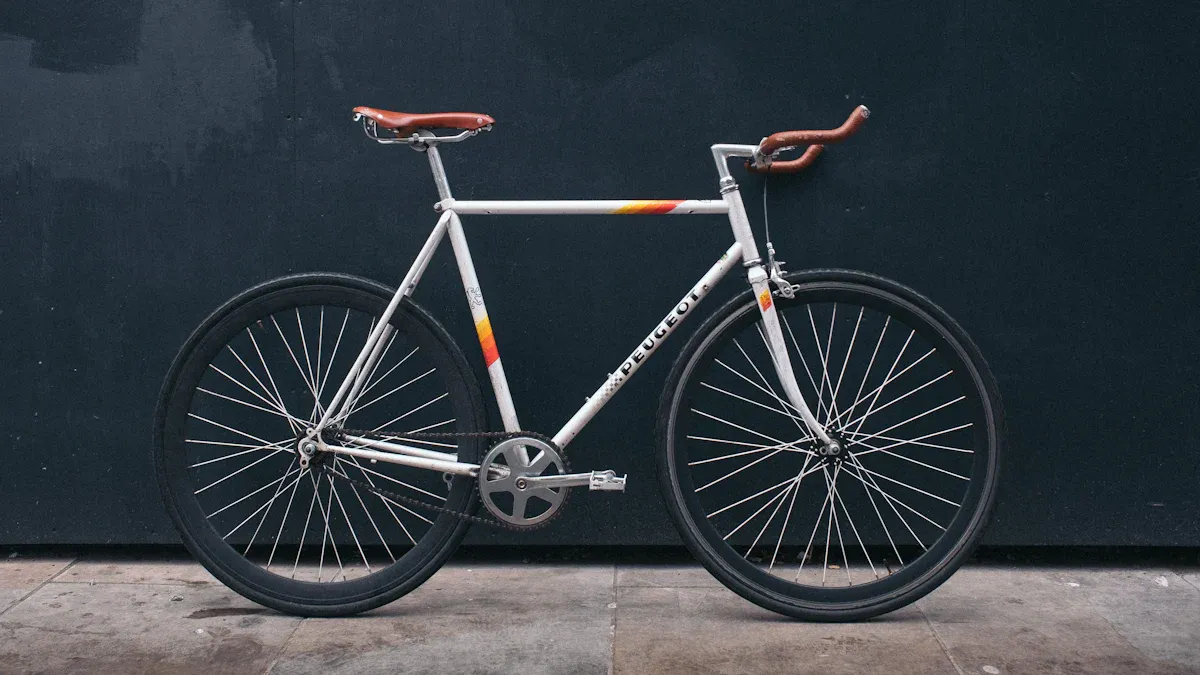
Choosing the right bike frame size is crucial for your comfort and performance on the road or trail, especially when considering typical bike frame sizes. If you don’t get it right, you might face discomfort or even injuries. Studies show that many cyclists struggle with issues like knee pain due to improper bike adjustments. Key factors like your height and leg length play a big role in finding that perfect fit among the typical bike frame sizes. This blog aims to guide you through the process of selecting the best bike frame size for your needs, ensuring an enjoyable riding experience.
Key Takeaways
You need to measure your height and inseam. This helps you find the right bike frame size. It keeps you comfortable and safe from injuries.
Different types of bikes have their own sizing systems. Road bikes use seat tube length. Mountain bikes use Small, Medium, and Large sizes.
Standover height is important for safety and comfort. You should have enough space to get on and off the bike easily.
Your personal choices are important when picking a bike. Try out different models to see which one fits your body and riding style best.
Always look at the sizing charts from the manufacturer. Sizes can be different between brands. Make sure you find the right fit for your bike.
Measuring for the Right Fit

Getting the right bike frame size starts with accurate measurements of your body. Two key measurements you need are your height and inseam length. These measurements help you find a bike that fits comfortably and allows you to ride efficiently.
Height Measurement
To measure your height accurately, follow these simple steps:
Stand against a wall with your heels touching it.
Make sure your head, shoulders, and back are straight.
Use a flat object, like a book, to place on top of your head, ensuring it’s level.
Mark the wall where the bottom of the book touches.
Measure the distance from the floor to the mark.
This measurement gives you your rider height, which is crucial for determining the appropriate bike frame size. If you want to be even more precise, consider using a high frame rate camera to record yourself pedaling. Mark your hip, knee, and ankle joints with contrasting tape for easier identification. Analyzing the video can help you measure joint angles at maximum knee extension and ankle position, ensuring a perfect fit.
Inseam Measurement
Your inseam length is another vital measurement that correlates directly with your bike frame size. Here’s how to measure it:
Stand in socks on a hard, flat surface with your feet about 6-8 inches apart.
Place a book or ruler between your legs, pressing it firmly against your crotch.
Ensure the book or ruler is level with the ground.
Measure the distance from the top of the book or ruler to the floor.
This measurement is essential because it affects both stand-over height and saddle height, which are crucial for rider comfort and control. To find your ideal bike frame size, you can use the formula: Leg inseam (A) * 0.7 = your frame size. Most bike manufacturers provide size charts that link inseam length and rider height to recommended frame sizes, although these can differ across brands and models.
In addition to height and inseam, consider measuring your arm span. Here’s how:
Stand and stretch your arms out to the sides, parallel to the floor.
Have a friend measure from the tip of one middle finger to the other.
If your wingspan is much greater than your height, you might need a bike with a longer reach. Conversely, if your wingspan is shorter than your height, a bike with less reach could be a better fit.
Remember, body proportions matter too! If you have short legs and a long torso, you might feel hunched on a bike that fits your height but not your proportions. Similarly, long legs paired with a short torso can create an excessive reach to the handlebars. Understanding these factors will help you choose a bike that feels just right.
Typical Bike Frame Sizes

When you pick a bike, knowing the typical bike frame sizes is very important. Each bike type has its own size rules. These rules can change how comfortable and well you ride. Let’s look at the standard sizes for road bikes, mountain bikes, and hybrid bikes.
Road Bike Sizes
Road bikes usually use a size system based on the seat tube length. This length is measured in centimeters. Here’s a quick table for suggested road bike sizes based on how tall you are:
Rider Height | |
|---|---|
5’3″ – 5’6″ | Small (52cm) |
5’6″ – 5’9″ | Medium (54cm – 55cm) |
5’9″ – 6’0″ | Large (56cm – 58cm) |
6’0″ – 6’3″ | X-Large (58cm – 60cm) |
6’3″ – 6’6″ | XX-Large (61cm – 63cm) |
This table helps you find the right size for your height. Remember, road bike sizing is about comfort, power, and aerodynamics. If you want women’s road bike sizes, they usually have similar measurements but may change a bit to fit different body shapes.
Mountain Bike Sizes
Mountain bikes use a different sizing system. They are often labeled as Small, Medium, or Large. This system focuses on how well the bike handles and stays stable for different riding styles. Here’s how mountain bike sizing is different from road bike sizing:
Bike Type | Key Focus Areas | |
|---|---|---|
Mountain Bike | Small/Medium/Large hierarchy | Handling and stability for various riding positions |
Road Bike | Measurements in centimeters | Comfort, power, and aerodynamics |
Mountain bike sizing looks at the bike’s shape. This shape can change how you ride on rough paths. If you want to ride on trails, pick a size that lets you reach the handlebars easily while keeping control.
Hybrid Bike Sizes
Hybrid bikes mix features from both road and mountain bikes. This makes them good for many riding situations. Here’s a sizing chart for hybrid bikes:
Size | Height (cm) | Height (ft) | Inseam (cm) | Inseam (in) |
|---|---|---|---|---|
S | 155.0 – 165.0 | 5’1.0″ – 5’5.0″ | 72.0 – 78.0 | 28.3″ – 30.7″ |
M | 165.0 – 175.0 | 5’5.0″ – 5’8.9″ | 77.0 – 83.0 | 30.3″ – 32.7″ |
L | 175.0 – 186.0 | 5’8.9″ – 6’1.2″ | 82.0 – 88.0 | 32.3″ – 34.6″ |
XL | 186.0 – 197.0 | 6’1.2″ – 6’5.6″ | 87.0 – 93.0 | 34.3″ – 36.6″ |
XXL | 197.0 – 203.0 | 6’5.6″ – 6’7.9″ | 92.0 – 95.0 | 36.2″ – 37.4″ |
This chart shows the sizes for hybrid bikes clearly. When you choose a hybrid bike, think about your height and inseam. This will help you have a comfortable ride.
Knowing these typical bike frame sizes will help you choose the right bike. Remember, the right fit makes your ride better. So, take time to measure yourself and check these sizing charts.
Bike Sizing Guide
When it comes to finding the right bike, a comprehensive bike sizing guide can make all the difference. Here’s a breakdown of the sizing charts for road bikes, mountain bikes, and hybrid bikes to help you make an informed decision.
Road Bike Sizing Chart
For road bikes, you’ll want to consider your height and inseam measurements. Here’s a quick reference chart:
Rider Height | Suggested Road Frame Size |
|---|---|
5’3″ – 5’6″ | Small (52cm) |
5’6″ – 5’9″ | Medium (54cm – 55cm) |
5’9″ – 6’0″ | Large (56cm – 58cm) |
6’0″ – 6’3″ | X-Large (58cm – 60cm) |
6’3″ – 6’6″ | XX-Large (61cm – 63cm) |
Tip: Remember to consider your riding style. Different styles may require different bike geometries.
Mountain Bike Sizing Chart
Mountain bike sizing can be a bit more complex. While most brands use standard sizes like Small, Medium, and Large, the frame geometry plays a significant role. Here are some key measurements to keep in mind:
Reach: This affects how far you lean over the handlebars.
Standover Height: Important for getting on and off the bike easily.
Wheelbase: Influences stability and handling.
Most mountain bike sizing charts will look something like this:
Size | Height Range (ft) | Height Range (cm) |
|---|---|---|
Small | 5’2″ – 5’6″ | 157 – 168 |
Medium | 5’6″ – 5’10” | 168 – 178 |
Large | 5’10” – 6’2″ | 178 – 188 |
X-Large | 6’2″ – 6’5″ | 188 – 196 |
Hybrid Bike Sizing Chart
Hybrid bikes combine features from both road and mountain bikes, making them versatile. Here’s a sizing chart to help you find the right fit:
Size | Height Range (cm) | Height Range (ft) | Inseam Range (cm) | Inseam Range (in) |
|---|---|---|---|---|
S | 155.0 – 165.0 | 5’1.0″ – 5’5.0″ | 72.0 – 78.0 | 28.3″ – 30.7″ |
M | 165.0 – 175.0 | 5’5.0″ – 5’8.9″ | 77.0 – 83.0 | 30.3″ – 32.7″ |
L | 175.0 – 186.0 | 5’8.9″ – 6’1.2″ | 82.0 – 88.0 | 32.3″ – 34.6″ |
XL | 186.0 – 197.0 | 6’1.2″ – 6’5.6″ | 87.0 – 93.0 | 34.3″ – 36.6″ |
XXL | 197.0 – 203.0 | 6’5.6″ – 6’7.9″ | 92.0 – 95.0 | 36.2″ – 37.4″ |
Note: Different brands may have variations in sizing, so always check the specific sizing guides for the brand you’re considering.
By using these sizing guides, you can find the right bike size that fits your body and riding style. Remember, the right fit enhances your comfort and performance on every ride!
How to Choose the Right Bike
Choosing the right bike involves more than just picking a color or style. You need to consider factors like standover height and reach to ensure comfort and performance.
Standover Height
Standover height is crucial for your safety and comfort. It refers to the distance between the ground and the top tube of the bike frame when you stand over it. Here’s what you should know:
Standover clearance is essential for comfort and safety when standing over the bike.
For road bikes with level top tubes, aim for a standover height that is 0-2 cm less than your Pubic Bone Height (PBH).
If your bike has a sloping top tube, it should be 2-3 cm less than your PBH.
Off-road bikes typically require 3-5 cm less than PBH, while fat bikes need 5-10 cm of clearance.
Having the right standover height allows you to mount and dismount easily. It also gives you confidence when stopping suddenly.
Reach and Comfort
Reach is another important measurement that affects how you feel on the bike. It’s the distance from the saddle to the handlebars. Here’s why it matters:
A proper reach measurement ensures a comfortable and efficient riding position. This reduces strain on your back, neck, and wrists.
An incorrect reach can lead to discomfort, such as cramping or overstretching, which affects your overall comfort.
A longer reach can enhance stability at high speeds, while a shorter reach improves maneuverability for tight turns.
When you think about how to choose the right bike, consider your riding style. Different styles require different bike geometries. For example, if you enjoy racing, you might prefer a bike with a longer reach for speed. If you like casual rides, a shorter reach might be more comfortable.
Common Sizing Mistakes
When picking the right bike frame size, many cyclists make mistakes. These mistakes can cause discomfort and make riding harder. Let’s look at two common problems.
Overlooking Personal Preferences
Your personal likes are very important for finding the right bike fit. Here are some mistakes to avoid:
Choosing based on wheel size: Many cyclists wrongly believe that wheel size decides bike fit. Instead, focus on the frame size and how it matches your body measurements.
Not comparing inseam or height: If you don’t compare your leg inseam or height to the seat tube length, you might end up with a bad fit. Always check these measurements against the sizing charts.
Assuming one size fits all: Just because a bike says “medium” doesn’t mean it fits everyone the same way. Each rider has different body shapes, so think about your comfort and riding style.
Tip: Take time to test ride different bikes. This will help you find what feels good for you.
Ignoring Manufacturer Variations
Different bike makers have their own sizing rules, which can change how a bike fits you. Here’s what to remember:
Comfort: A bike that fits well stops discomfort during long rides. This helps reduce back pain and strain.
Efficiency: The right size helps you pedal better, giving you more power for better performance.
Safety: A correct fit makes it easier to control the bike and stay stable, lowering accident risks.
Long-Term Health: A bike that fits well helps prevent injuries and keeps your joints aligned.
Enjoyment: The right fit makes riding more fun and encourages you to explore.
To avoid these common sizing mistakes, remember to:
Adjust your fit when changing equipment: Changing parts can affect your fit. Pay attention to changes in saddle height and reach to the handlebars.
Get fitted for every bike you ride: Different bike types need different fits.
Be open to advice: Ongoing issues may have complex causes. Be willing to try exercises or stretches that can help.
By knowing these common mistakes, you can make a better choice when picking your bike frame size.
Picking the right bike frame size is very important for your comfort and how well you ride. Make sure to measure your height and inseam correctly. Just using your height can lead to a bike that doesn’t fit well, so think about your body shape too.
Getting the right measurements is key to finding a bike that matches your body and riding style. This helps you feel more comfortable and ride better, which is important for enjoying cycling over time.
A good fit makes your biking experience better. It also helps stop injuries and makes riding more fun. So, before you wonder, “what size bike should I get,” take time to measure yourself and find the best fit!
FAQ
What is kid bike sizing?
Kid bike sizing refers to the process of selecting the right bike size for children based on their height and inseam measurements. Proper sizing ensures comfort and safety while riding.
How do I measure my child’s inseam for bike sizing?
To measure your child’s inseam, have them stand straight with their feet slightly apart. Use a book pressed against their crotch and measure from the top of the book to the floor. This measurement helps determine the appropriate children’s bike sizes.
Why is it important to choose the right bike size for kids?
Choosing the right bike size for kids is crucial for their safety and comfort. A properly sized bike allows for better control and reduces the risk of accidents, making riding more enjoyable.
Are there specific children’s bike sizes available?
Yes, children’s bike sizes vary based on age and height. Manufacturers often provide sizing charts to help you find the right fit for your child, ensuring they have a comfortable riding experience.
How can I ensure my child’s bike fits them as they grow?
To ensure your child’s bike fits as they grow, consider adjustable features like the seat height and handlebars. Regularly check their fit and make adjustments as needed to accommodate their growth.
See Also
Understanding Bike Frame Sizes for Every Type of Rider
How to Determine the Perfect Bike Frame Fit
Easily Discover Your Perfect Downhill Bike Frame Size
Use a Bike Frame Size Calculator for Perfect Fit
Beginner’s Guide to Understanding Cyclocross Bike Frame Sizes
